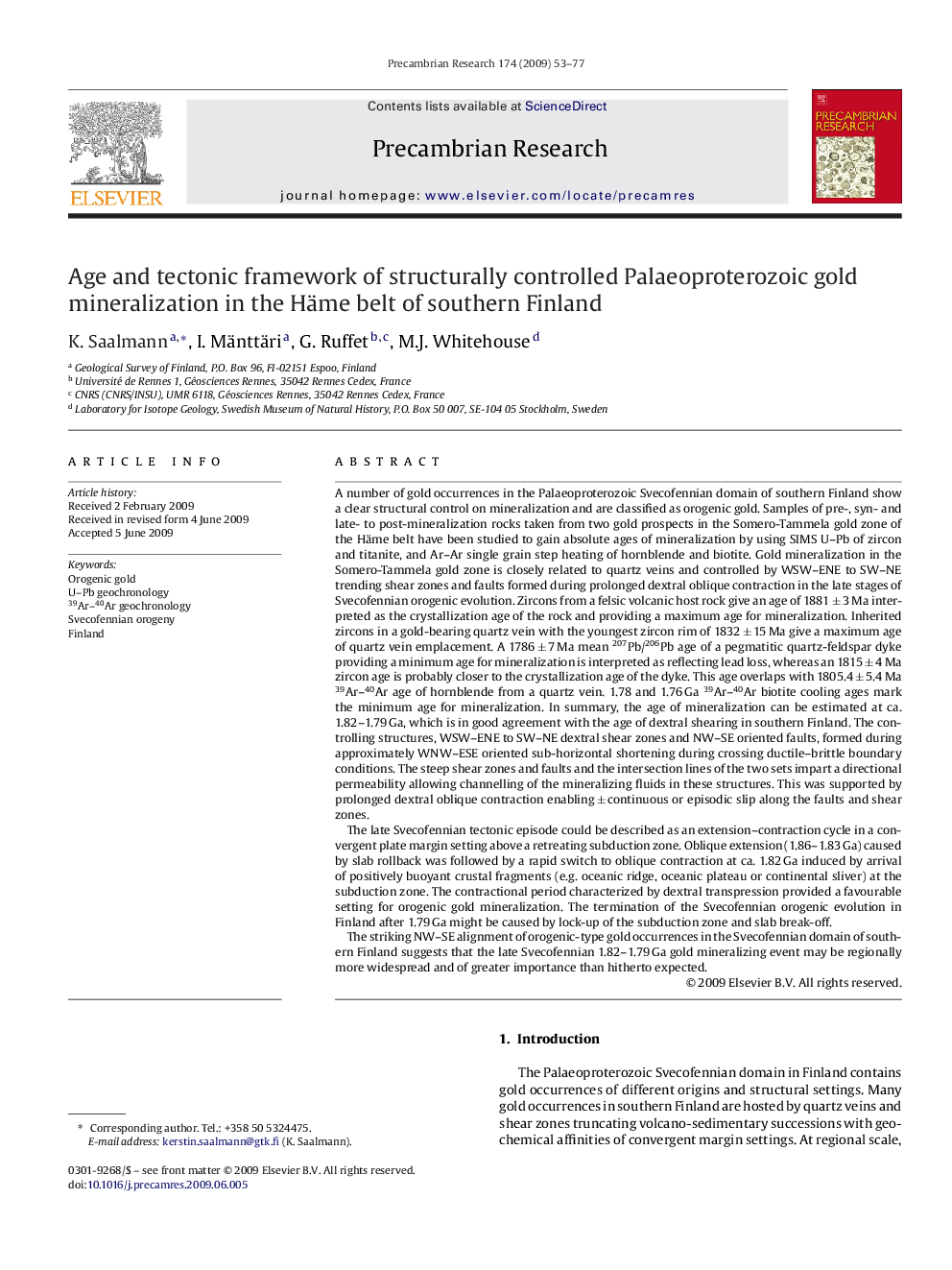| کد مقاله | کد نشریه | سال انتشار | مقاله انگلیسی | نسخه تمام متن |
|---|---|---|---|---|
| 4723948 | 1639686 | 2009 | 25 صفحه PDF | دانلود رایگان |

A number of gold occurrences in the Palaeoproterozoic Svecofennian domain of southern Finland show a clear structural control on mineralization and are classified as orogenic gold. Samples of pre-, syn- and late- to post-mineralization rocks taken from two gold prospects in the Somero-Tammela gold zone of the Häme belt have been studied to gain absolute ages of mineralization by using SIMS U–Pb of zircon and titanite, and Ar–Ar single grain step heating of hornblende and biotite. Gold mineralization in the Somero-Tammela gold zone is closely related to quartz veins and controlled by WSW–ENE to SW–NE trending shear zones and faults formed during prolonged dextral oblique contraction in the late stages of Svecofennian orogenic evolution. Zircons from a felsic volcanic host rock give an age of 1881 ± 3 Ma interpreted as the crystallization age of the rock and providing a maximum age for mineralization. Inherited zircons in a gold-bearing quartz vein with the youngest zircon rim of 1832 ± 15 Ma give a maximum age of quartz vein emplacement. A 1786 ± 7 Ma mean 207Pb/206Pb age of a pegmatitic quartz-feldspar dyke providing a minimum age for mineralization is interpreted as reflecting lead loss, whereas an 1815 ± 4 Ma zircon age is probably closer to the crystallization age of the dyke. This age overlaps with 1805.4 ± 5.4 Ma 39Ar–40Ar age of hornblende from a quartz vein. 1.78 and 1.76 Ga 39Ar–40Ar biotite cooling ages mark the minimum age for mineralization. In summary, the age of mineralization can be estimated at ca. 1.82–1.79 Ga, which is in good agreement with the age of dextral shearing in southern Finland. The controlling structures, WSW–ENE to SW–NE dextral shear zones and NW–SE oriented faults, formed during approximately WNW–ESE oriented sub-horizontal shortening during crossing ductile–brittle boundary conditions. The steep shear zones and faults and the intersection lines of the two sets impart a directional permeability allowing channelling of the mineralizing fluids in these structures. This was supported by prolonged dextral oblique contraction enabling ± continuous or episodic slip along the faults and shear zones.The late Svecofennian tectonic episode could be described as an extension–contraction cycle in a convergent plate margin setting above a retreating subduction zone. Oblique extension (1.86–1.83 Ga) caused by slab rollback was followed by a rapid switch to oblique contraction at ca. 1.82 Ga induced by arrival of positively buoyant crustal fragments (e.g. oceanic ridge, oceanic plateau or continental sliver) at the subduction zone. The contractional period characterized by dextral transpression provided a favourable setting for orogenic gold mineralization. The termination of the Svecofennian orogenic evolution in Finland after 1.79 Ga might be caused by lock-up of the subduction zone and slab break-off.The striking NW–SE alignment of orogenic-type gold occurrences in the Svecofennian domain of southern Finland suggests that the late Svecofennian 1.82–1.79 Ga gold mineralizing event may be regionally more widespread and of greater importance than hitherto expected.
Journal: Precambrian Research - Volume 174, Issues 1–2, October 2009, Pages 53–77